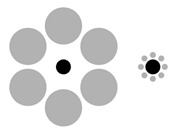
We all know that visuals are one of the key components of any presentation. Yet, whilst we know how we like our visuals to appear to our clients, there is rarely a question raised of why they might appeal to them. The visual system is a largely complex network facilitating the processing of fine detail and perception. This in turn, can drive multisensory function. So, in aiming for the presentation gold standard, what can we learn from sensory neuroscience?
First we must understand some basics about the visual system before we delve into its relevance in the B2B environment. Specific parts of the visual cortex respond to specific aspects of the visual scene. Some neurons respond to orientation, whilst others respond to motion and others to colour. The system is constructed in a hierarchical manner, with basic orientation processed first, and more complex considerations last. Together, these regions allow us to map the visual scene and process incredibly complex inputs in our everyday lives. An understanding of such visual processing can give us scope to appeal not only to the client, but to the visual system itself in our presentations.
Key Learning 1
The way we colour our slides is a more complex activity than surface-level appearance. It is a way in which we can manipulate visual neurons to attend to what we want them to attend to.
There is often much speculation with regards to the use of colour on our slides. What constitutes as the right amount of colour, and what is too much? As we know, a set colour palette allows us at B2B International to be consistent, yet how we use it might allow our visualisations to be more effective. Evolutionarily speaking, the visual system has had to become adept at processing colour contrasts in order to avoid predators in the sky1. This means that specific cones in the eye prefer dark contrasts on light backgrounds. Hence, perhaps highlighting important aspects of slides with darker colours will attract attention to them more than if they were in a light colour on a light background. Contrast is key.
Key Learning 2
Keeping consistency is crucial, as seemingly small changes can manipulate visual perception.

Figure 1: Titchener Circles
Visual illusions are a good illustration of how visual perception can be manipulated. The Titchener Circle illusion (Figure 1) is a prime example of visual manipulation. Whilst the black dots are actually the same size, the visual system is manipulated into thinking that the black circle on the right is larger. This is largely due to the distance between the grey dots and the central black dot. We have learnt from such illusions that the brain processes visual cues (in this case the black circle) in the context of their background3. Hence, in order to facilitate the easiest route for the visual system, we should work to keep visualisations simple, and backgrounds consistent in order to avoid undesirable perceptual manipulation.
Key Learning 3
The visual system is not a stand-alone entity and hence neither are our PowerPoint presentations. A magnitude of factors influence how our audience process visual information, such as attention, prior knowledge of information, and the behaviour of the presenter themselves.
We often think of our visualisations and our style of presenting as separate entities. The brain is not as simple as this assumption would suggest. The interconnected nature of neurons in the brain means that we process visual information alongside other complex variables such as attention, prior knowledge, and the presenter. Interestingly, recent investigations4 have yielded information to suggest that the loudness of the presenter’s voice can influence visual processing. That is, when presented with louder sounds, we can process visual information faster than if presented with no sound or a quiet sound. This would suggest that vocal presence is key to capturing not only the audience’s attention, but the function of the visual system too.
Accomplished visual search in a scene is likely to rely on both experience and attention. When analysing a visual scene, we are likely to look for and pay attention to areas of the scene where we expect our desired information to be2. So, for instance, if I was looking for the B2B International logo on one of our presentations, my visual system would be likely to pay attention to the bottom right of the screen, as this is where I have learnt that this information is likely to be. From this, we can learn that keeping key information in the same location on our presentations can make visual processing easier for our audience, as they will already have this information stored in memory. This, in turn, will enhance attention to important aspects of the presentation.
Conclusion
There is much information that we can take from visual neuroscience in order to better understand our audience, and why they are likely to behave in some manners and not in others. Understanding processes of the visual system in this instance allows us to enhance the ways we present information, so that they are the most efficient they can be. From visual neuroscience, we can answer the questions of how and why our visualised presentations appeal to our clients.
References
1Baden, T., Schubert, T., Chang, L., Wei, T., Zaichuk, M., Wissinger, B. and Euler, T., 2013. A tale of two retinal domains: near-optimal sampling of achromatic contrasts in natural scenes through asymmetric photoreceptor distribution. Neuron, 80(5), pp.1206-1217.
2Kondo, H.M., van Loon, A.M., Kawahara, J.I. and Moore, B.C., 2017. Auditory and visual scene analysis: an overview.
3Pavani, F., Boscagli, I., Benvenuti, F., Rabuffetti, M. and Farnè, A., 1999. Are perception and action affected differently by the Titchener circles illusion?. Experimental Brain Research, 127(1), pp.95-101.
4Petersen, A., Petersen, A.H., Bundesen, C., Vangkilde, S. and Habekost, T., 2017. The effect of phasic auditory alerting on visual perception. Cognition, 165, pp.73-81


